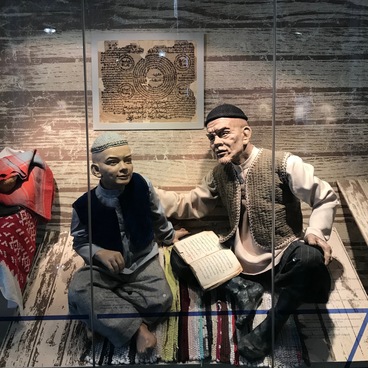The portrait of the fifth ruler of the Golden Horde, Berke Khan, was painted by famous illustrator and artist from Tatarstan Rushan Shamsutdinov and is part of the series of portraits of the rulers of the Golden Horde and the Kazan Khanate, created by the artist. Rushan Shamsutdinov did something that no one had succeeded before: he reconstructed and externalized in visible artistic images historically significant representatives of Turkic peoples from ancient times.
The painter created portraits of Sultans of the Volga Bulgaria, Khans of the Kazan Khanate and the Golden Horde, as well as Tatar poets of the past, which later became part of the national art treasury. The winner of the Qol Ghali International Award, Rushan Shamsutdinov is considered the leading book graphic artist of Tatarstan - more than five hundred books are illustrated by his graphic drawings, including heroic epics, historical and artistic works. The artist, calligrapher and talented illustrator works in oil, pastel and water colours. His paintings are reposited in museums of Kazan, in all-Russian and foreign treasure-houses.
Genghis Khan’s grandson and Batu’s brother, the fifth ruler of the Ulus of Jochi, is a significant figure in the Golden Horde history. He was the first ruler of the Horde to convert to Islam. The date of the historical event is inaccurate, historians mention the 40s of the 8th century.
The huge Mongol Empire swallowed the territory of the Volga Bulgaria in 1236. The Bulghar Vilayat with its capital in the city of Sarai initially passed into the hands of Genghis Khan’s son, Jochi, and therefore received the name Ulus (state) of Jochi. By the time of Berke’s reign, the destroyed structure of the Volga Bulgaria was almost restored, the capital was moved to the city of Bulghar, and a gradual transition of pagan nomads to settled way of life and Islam began.
From the portrait by the talented artist, a wise and judicious ruler, strategist and gifted politician is looking at us. His remarkable military and diplomatic talents found use in 1263–1264, when almost the entire Mongol Empire united against him, eager for his destruction. The pagan Mongols could not come to terms with Muslim rule in one of the uluses, the Berke Khanate was left without support, and the ruler only relied on the local Turkic peoples - the Pechenegs and Polovtsy. Interethnic marriages were being actively concluded, a mixing of elites took place.
The Khan managed to maintain power despite the hostile sentiment of most rulers of the Horde. It was under Berke that the transformation took place: the Mongol-Tatar Ulus became the Turkic-Mongol Golden Horde. Burke pursued a policy of Islamization, but not by force, although historians have noted the rough temper of the Khan. He understood that only after gaining a single religion the state would become monolithic and able to withstand an external enemy.
The painter created portraits of Sultans of the Volga Bulgaria, Khans of the Kazan Khanate and the Golden Horde, as well as Tatar poets of the past, which later became part of the national art treasury. The winner of the Qol Ghali International Award, Rushan Shamsutdinov is considered the leading book graphic artist of Tatarstan - more than five hundred books are illustrated by his graphic drawings, including heroic epics, historical and artistic works. The artist, calligrapher and talented illustrator works in oil, pastel and water colours. His paintings are reposited in museums of Kazan, in all-Russian and foreign treasure-houses.
Genghis Khan’s grandson and Batu’s brother, the fifth ruler of the Ulus of Jochi, is a significant figure in the Golden Horde history. He was the first ruler of the Horde to convert to Islam. The date of the historical event is inaccurate, historians mention the 40s of the 8th century.
The huge Mongol Empire swallowed the territory of the Volga Bulgaria in 1236. The Bulghar Vilayat with its capital in the city of Sarai initially passed into the hands of Genghis Khan’s son, Jochi, and therefore received the name Ulus (state) of Jochi. By the time of Berke’s reign, the destroyed structure of the Volga Bulgaria was almost restored, the capital was moved to the city of Bulghar, and a gradual transition of pagan nomads to settled way of life and Islam began.
From the portrait by the talented artist, a wise and judicious ruler, strategist and gifted politician is looking at us. His remarkable military and diplomatic talents found use in 1263–1264, when almost the entire Mongol Empire united against him, eager for his destruction. The pagan Mongols could not come to terms with Muslim rule in one of the uluses, the Berke Khanate was left without support, and the ruler only relied on the local Turkic peoples - the Pechenegs and Polovtsy. Interethnic marriages were being actively concluded, a mixing of elites took place.
The Khan managed to maintain power despite the hostile sentiment of most rulers of the Horde. It was under Berke that the transformation took place: the Mongol-Tatar Ulus became the Turkic-Mongol Golden Horde. Burke pursued a policy of Islamization, but not by force, although historians have noted the rough temper of the Khan. He understood that only after gaining a single religion the state would become monolithic and able to withstand an external enemy.



